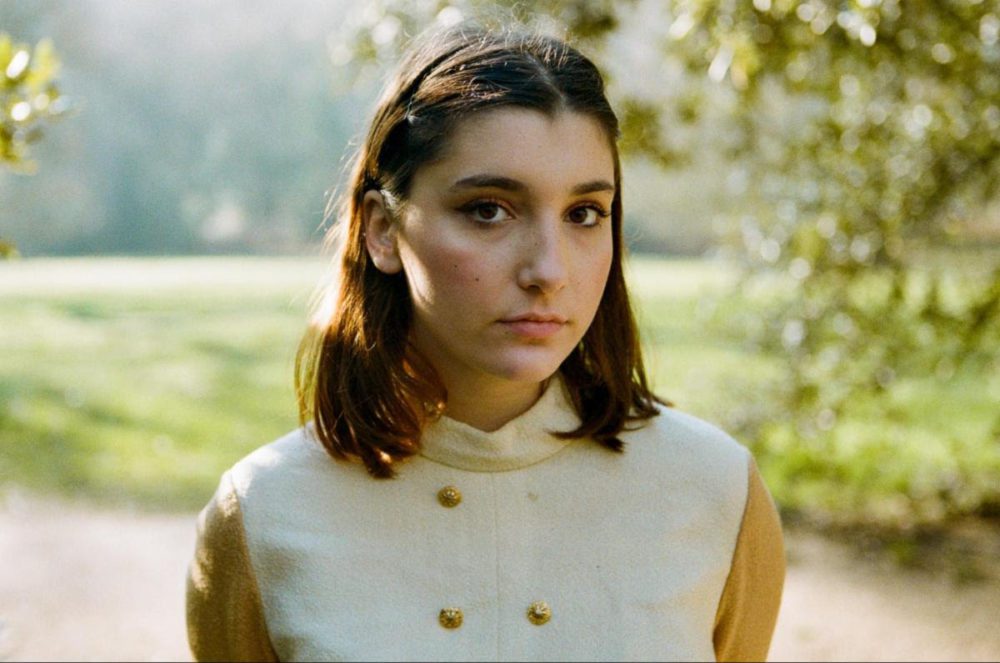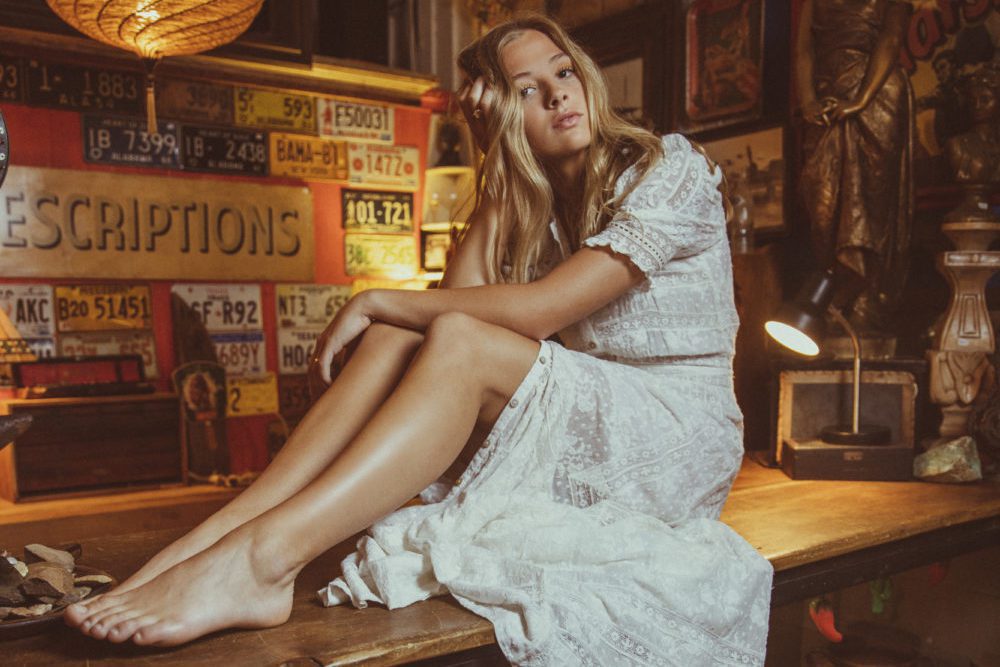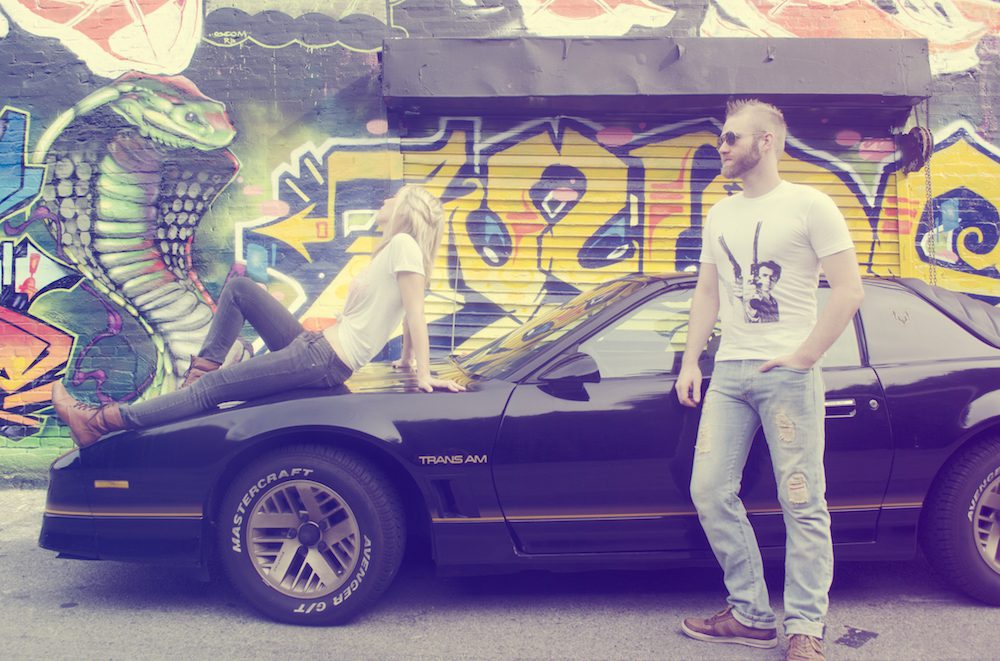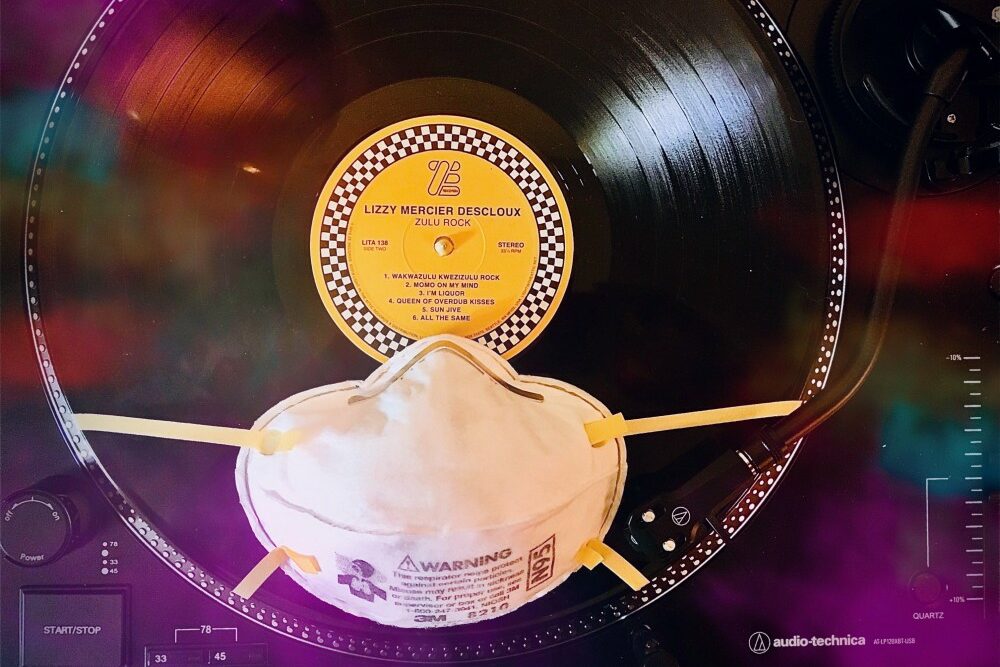How Support From Her Sister (and Aaron Dessner) Brought Eve Owen’s Debut LP to Life


Don’t Let The Ink Dry, the lush, haunting debut album from British singer-songwriter Eve Owen, is a testament to how far young women can go when they feel supported. Struggling with loss and alienation at school, Owen spent her summer holidays in Hudson, New York with The National’s Aaron Dessner, recording some forty tracks over the last three years in his Long Pond Studio. Twelve of them would end up on Ink; Dessner’s purposeful electronic flourishes expand Owen’s deeply thoughtful lyrics and emotive vocal delivery that can’t help but remind one of Sharon Van Etten’s earliest albums.
“Aaron was so kind in letting me be myself. I know that sounds really simple but for me that was a really big deal,” Owen says of their work together. “In other situations I have felt like I have to project this person who isn’t necessarily me, and I think why I was so comfortable in that space was I knew I could tremble and choke and shiver and I could show all my nerves but I wasn’t embarrassed by it.”
But before Owen met Dessner, her biggest champion was, without a doubt, her older sister Hannah. The two grew up singing Taylor Swift songs at the family piano, though as they entered their teen years their interests began to diverge. Eve began expressing herself via original compositions, while Hannah gravitated toward musical theater and eventually went to film school, where she’ll complete her studies next year. In the lead up to the release of Don’t Let The Ink Dry, the two collaborated on a series of four music videos that inadvertently documented Eve’s growing confidence and artistic growth. “I think that was due to our relationship, and due to my happiness just with the album in itself,” Eve says. “I’ve definitely grown to be proud of [the songs], which is a really nice feeling.”
“I think if I’m being honest, there was no plan before we started,” Hannah admits. “We were very aware that we wanted to explore different tones and styles and personalities and characters within all four of the videos, cause the songs are all so different. I recently watched back all four of them, and I actually think they really speak to the journey that Eve’s been on.”
That journey is one of a sensitive, soft-spoken young woman who once struggled to fit in finding her voice. In the first video, a somber, stuttering, black and white stop-motion clip for “She Says,” Eve twirls around an empty room with little company save for a posable artist’s mannequin, her eyes wide and a little sad-looking. The soaring piano ballad, written when Eve was just fourteen, sees her inhabiting a character feeling loss and abandonment from a family member. “It’s not actually about my family,” Eve says. “I was just interested in the idea of how abandonment from anyone is such a strong, overwhelming feeling. For the video, we wanted to show that it was about the hunger for connection and being so desperate for relationships, you find it in ways that aren’t obvious or normal, like creating your own connections with inanimate objects. I think the stop motion really works in that favor, because I get this feeling watching it where everything’s a bit off, like you’re trying really hard to connect and do what everyone else is doing but it’s this awkwardness that doesn’t quite feel natural.”
Hannah painstakingly shot each frame as a photo on iPhone before editing them together. “There were these snapshot moments – Eve was having to hold [poses] for a long time while I was doing my thing. When we played it back it was almost surreal actually, cause you’re not witnessing that in real time, we speed it all up. It was an interesting way to work for the first video because it forced us both to just slow down and think about the song and what the first video was going to be.”
The other shoots were more free-flowing, with no set schedule. Eve says her sister’s direction put her at ease in a way she couldn’t have been with another director, and by extension, it’s easy to live vicariously through the intimacy of their relationship. It’s a rare treat to see so much of a nascent artist’s personality so viscerally and immediately, and Hannah’s videos offer just that. The next one they shot, for the aching, lilting “So Still For You,” follows Eve across a desolate beach just as the sun dips below the horizon; before a backdrop of purple clouds, Eve slams herself into the sand, a literal interpretation of being stuck in a suffocating relationship.
“As Eve’s older sister, we knew this was gonna be a really special time of Eve releasing these songs. We’ve watched her grow up with these songs for such a long time – finally, people are gonna hear them,” Hannah says. “I wanted to get that rough part of her, the willingness to throw her face in a pile of mud and be free with it, because there’s something quite definite about handing songs over into the world – [it becomes] somebody else’s and they’ll do what they want to do with it.”
Shot in the beginning of January, Eve said it was freezing. “I didn’t even have boots or anything, I was just in trainers in the mud,” she recalls. “I made a mess of everything!” As much as it’s a portrait of Eve, Hannah’s behind-the scenes presence is strongly felt, too. “It was 25 minutes of just like pure sister relationship, because I’d be shouting at her, like, ‘Smack your face in the mud a bit harder!'” Hannah says with a laugh. “Eve would be like, ‘I don’t wanna do that, I wanna do this!’ and she’d run away from me. It was just a total push and pull of both of our personalities but it kind of came across in these kind of wild, very natural and raw moments.”
Hannah appears on camera in the video for “Blue Moon,” alongside Eve in snippets of home movies from their childhood. These are interspersed with shots of Eve setting up for gigs, tuning her guitars, goofing off, recording in Hudson – a documentary, essentially, of Eve’s whole life. “By that point, there was a little bit of curiosity in the air of people online wondering about Eve’s journey, the album coming out with Aaron, who she is…” Hannah says. Eve had contributed lead vocals to “Where is Her Head,” from The National’s 2019 LP I Am Easy To Find, but had otherwise remained mysterious until the rollout for Ink began.
Comparing the old footage to current-day “miming and mucking around,” Hannah was surprised to see how little had changed in Eve’s mannerisms over the years. “Seeing how prevalent it is from when she’s like four years old, when she’s feeling like a camera’s on her, she acts in a certain way that’s been the same. We got to a point in the edit where I was really just being led by her, who she is and who she has become and letting those different moments of Eve and where she sat in different points in her life, kind of talk to each other.”
“When I was watching the first cut I got this overwhelming sense of me now sort of singing this song to my younger self,” says Eve. “The chorus goes, ‘I’ll never let you break/I’ll clean up your mistakes.’ I love that idea of looking back at your past selves and going, don’t give up just yet, it does get better and you do get happier.” It wasn’t her original motivation for writing it; the soulful number is more about accepting love as a beautiful feeling, even when it’s unrequited. “I watched it and was like, that is so new to me, but it feels so right.”
It’s almost as if these three videos act as the ingredients in a recipe for artistic birth: “She Says,” seeks inspiration; “So Still For You,” is a hefty shake of raw emotion; “Blue Moon” the dash of support needed to turn that spark to fire. The fourth and final video Hannah and Eve made together, for “Mother,” is the culmination of all of that. Eve rummages through stories she wrote and art she made as a child, sometimes finding interesting through lines (the final track on Ink, called “Lone Swan” has an eerily similar title to a tale Eve penned in year seven, “The Lonely Duck”). She displays it all in a makeshift gallery, overwhelmed at some points by its volume. One gets the sense she must have felt the same way sorting through all the tracks she’d recorded with Dessner, assembling the worthiest for her debut.
“‘Mother’ was the video that had the most friction between the two of us in terms of where we wanted to go, cause it was the first song where I had quite a strong idea of what the song was about and what it meant to me, and that wasn’t at all how Eve had set out wanting that song to feel for other people,” Hannah says. “It was just kind of a weird moment where the song became the third person in our relationship. We had a lot of sit-down conversations about the video, and I think, in a really lovely way Eve had become more confident and comfortable with the idea of visually portraying what a song means as we made [the other] videos. We were having like, proper, kind of intense discussions about ideas and what it meant to [both of] us, and we kind of mashed that together.”
But, Eve says, much like her recording process with Dessner, she always felt listened to and appreciated working with Hannah. “I never felt like I had to shout or do something that wasn’t in my character to get a point across,” she says. “The whole collaborating thing is very new; I feel lucky that Aaron and Hannah are very kind toward the process, but still straightforward.”
Don’t Let The Ink Dry came out on May 8th via Dessner’s 37d03d label, which has mostly released side projects from established indie artists, like Big Red Machine, Dessner’s collab with Justin Vernon of Bon Iver, or Bonnie “Prince” Billy’s joint effort with Aaron’s brother and National cohort Bryce. It’s a startling debut by any metric, each song offering a distinct and salient experience: the ghostly atmospherics of “Tudor;” the urgent, Radiohead-esque “After The Love;” the salient imagery and fluttering drum fills of “Bluebird;” and the gut-punch of “29 Daisy Sweetheart,” as heartbreaking a tale of loss as any written since Sleater-Kinney’s “The Size Of Our Love.”
Eve says that at first, she didn’t realize she was making an album with Dessner at all. “I was so into this idea of just having a fun time and creating for the sake of it,” she explains. “I never recorded with the idea that it would be on an album and people might hear it one day. It felt so personal that I was going, let’s just record this so we don’t forget it. Aaron saw things in songs that I would completely dismiss. That was a really important lesson to learn, that what I find interesting and good about a song isn’t the same as everyone else.”
Hannah says it’s hard for her to pick a favorite, but that Dessner’s production choices often made her jaw drop after having lived with the acoustic versions for so long. “Those songs not only tie to my life but also my experience of watching Eve and what she was doing and how she was feeling and what place she was in. All of those moments are equally really powerful for me,” she says. “There was a natural ebb and flow growing up – one of us will take quite a big step forward, and it will kind of naturally happen where the other person will [follow]. In the last couple of years, we’ve come together to this point where we’re both going through really exciting times, doing things that I think would have scared us a couple of years ago.”
“What I instinctively feel is that our sisterhood is so like, solid,” Eve adds. “All these things that we’re trying out are just sort of, in a lovely way, phases, or explorations. It feels to me that we’re very intrigued by what we can do next, but we’ve always got that surety of our sisterhood that will carry us.”
Follow Eve Owen on Facebook for ongoing updates.




